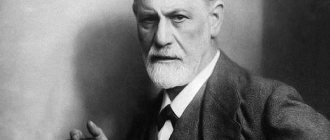Sigmund Freud (1856-1939) - Austrian psychologist, psychoanalyst, psychiatrist, founder of psychoanalysis and the psychoanalytic movement in general. In his research he made little use of the usual experimental approach, although he was convinced that his work was strictly scientific in nature. Freud also believed that analysis of patients' case histories and his own self-analysis provided sufficient basis for conclusions.
To a greater extent, S. Freud was interested in those subjects that, as a rule, had previously remained unattended: unconscious motivation of behavior, conflicts between the forces of the unconscious and their consequences for the human psyche.
Life instinct and death instinct
Instincts are the driving, motivational forces of the individual, biological factors that release reserves of mental energy. For Freud, instincts are not innate reflexes, but that part of the stimulation that comes from the body. The purpose of instincts is to eliminate or reduce stimulation through certain types of behavior (for example, eating or sexual activity).
Z. Freud identified 2 large groups of instincts: life and death.
Life instincts (Eros) include hunger, thirst, sexual activity and are aimed at the self-preservation of the individual and the survival of the species. These are creative, life-sustaining forces. The form of psychic energy in which they manifest themselves is called libido. Libido is a certain amount of mental energy that finds release exclusively in sexual behavior.
Freud believed that humans also have a desire for death. Death instincts (Thanatos) are destructive forces that can be directed both inward (masochism or suicide) and outward (hatred and aggression). Unlike the energy of libido, as the energy of the life instincts, the energy of the death instincts has not received a special name. However, Freud considered them biologically determined and as important in the regulation of human behavior as the life instincts. Towards the end of his life, Freud increasingly became convinced that the instinct of aggression could be very powerful as a motivating factor.
What are we running into?
The quick review is over, and we have come to a line that not everyone is able to cross. What I will talk about next is difficult to understand, since it requires a certain amount of thought or, in the words of materialists, an overexpenditure of energy by the neocortex to create new neural connections.
I promise to speak simply and not be foggy. I will not quote Gödel, de Saussure, Husserl, Peirce, Schrödinger, Bohm, Penrose and other outstanding thinkers. What cannot be explained on fingers is not worth explaining.
Three-component structural model of the psyche
In his early works, S. Freud singled out only the conscious and unconscious aspects of personality. The conscious part is small, as if it is only the tip of the iceberg, and in its essence is not significant. But the unconscious part is vast, occupying most of the iceberg. The subconscious mind contains the instincts and driving forces of human behavior.
Over time, Freud revised this simple division into conscious and unconscious and began to talk about the relationship between the three components of personality - Id (It), Ego (I) and Super-Ego (Super-I) .
1. Id (It) is a source of primitive biological drives and instincts, entirely related to the sphere of the unconscious. This is the most primitive and least accessible part of the personality; it is the original, primitive structure of the psyche. The id is closely related to biological drives (sleep, food, water, sexual desire, etc.) that energize human behavior.
Id stimuli demand immediate gratification without regard to anything else. They operate according to the pleasure principle, which seeks only opportunities to relieve tension by seeking pleasure and avoiding pain. The id is the main source of our psychic energy, libido, which manifests itself in the form of tension. An increase in libidinal energy leads to an increase in tension, which we then try in various ways to reduce to a normal level. For example, if a person is thirsty, he must satisfy his need for water. This will reduce the tension caused by thirst.
The id is like a small child who does not yet understand the rules of the world around him. He actively tries to get everything to satisfy his desires and needs, without assessing his capabilities and abilities, possible inconveniences for himself and others, as well as the consequences of his actions. For him, only “I want” exists, so the Id is controlled by the Ego.
2. Ego (I) is the rational and most conscious part of the personality, designed to adapt the impulses of the Id to social, economic and other restrictions imposed by the outside world.
This component of the psyche is responsible for decision making; this is the area in which intellectual processes occur. The ego seeks to express and satisfy the desires of the id in accordance with the requirements and restrictions imposed by the external world (in a way that is safe for the individual and adequate for society).
The ego is oriented toward causality and rationality, unlike the id. It follows the principle of reality, restraining the impulses of the id until a suitable object is found with the help of which the need can be satisfied and mental stress relieved.
The ego does not exist separately from the id. Moreover, the Ego derives its strength from the Id. The Ego itself exists, in fact, to help the Id.
3. Super-Ego (Super-I) is an internalized system of norms, rules and restrictions imposed on an individual by family and society, which is partly realized and partly remains in the unconscious.
The superego represents morality. From this it becomes clear why the Super-Ego cannot help but conflict with the Id, i.e. with a structure that does not recognize morality or any norms. Unlike the Ego, which tries to delay the fulfillment of the desires of the Id until a more appropriate opportunity, the Super-Ego intends to completely suppress these desires.
A person is not born with a Super-Ego. It is formed in the process of socialization - starting from the period when the child first learns what is “good” and what is “bad” and begins to distinguish between “right” and “wrong” (3-5 years). Children acquire a superego through their interactions with parents, teachers, and other “formative figures.”
As a result, the Ego appears, according to Freud, as an arena of continuous struggle between powerful and incompatible forces. He constantly has to maneuver between a rock and a hard place, trying to cope with the insistence and impatience of the id, correlate his actions with reality, relieve mental stress, and at the same time also deal with the continuous desire of the superego for perfection. In cases where the Ego is subjected to too much pressure, a situation called anxiety arises.
Olfactory vector.
general characteristics
- the color of greatest comfort is purple
- geometry of greatest comfort - zigzag
- place in the quartel – inner part of the ENERGY quartile, introvert
- type of thinking – intuitive; strategic
- people with the olfactory vector are less than 1%.
Key challenge: identifying potential hazards before they become real. Survive at all costs. Species role: shaman, sorcerer , adviser to the leader, strategic intelligence officer, eminence gray. Possible disadvantages: excessive suspicion, distrust of others.
Personal defense mechanisms
Anxiety is a kind of warning that the Ego is in danger. Freud suggested that the Ego erects a kind of barrier against anxiety - defense mechanisms , which represent a subconscious denial or distortion of reality.
Defense mechanisms (psychological defenses of the individual) are certain types of behavior designed to protect the Ego (I) from anxiety generated by conflicts in everyday life.
1. Denial is the process of eliminating, ignoring the traumatic perception of external reality. For example, a terminally ill person denies the inevitability of death.
2. Substitution is the switching of id impulses from one object, inaccessible or fraught with a threat, to another, more accessible one. Those feelings and actions that should have been directed at the object that caused the anxiety are transferred to another object.
For example, replacing hostility towards your boss with pickiness towards your own child. In television reports about football matches, we often see how an attacker, who misses the target, sends the rebounding ball with a strong blow, in any direction. In this way, the accumulated energy is discharged.
3. Projection is a situation in which an anxiety-producing impulse is attributed to someone else. Most often, this is an unconscious mechanism through which impulses and feelings that are unacceptable to the individual are attributed to an external object and penetrate into consciousness as an altered perception of the external world.
He transfers (projects) his own desires, feelings and personality traits, which a person does not want to admit to himself because of their ugliness, onto another person.
For example, someone claims that in fact it is not he who hates his professor, but that he dislikes him. Or a stingy person, who, as a rule, sees in other people primarily greed, and an aggressive personality considers everyone around him to be cruel.
4. Rationalization is the reformulation of behavior in such a way that it becomes more understandable, more acceptable, and therefore less frightening to others. The function of rationalization is to disguise, hide from the consciousness of the subject the true motives of his actions, thoughts and feelings in the name of ensuring internal comfort, preserving self-esteem, self-respect.
Often this mechanism is used by a person to prevent the experience of guilt or shame. When this mechanism operates, the awareness of those motives that appear to be socially unacceptable or disapproved is blocked. A person, after some actions, actions dictated by unconscious motives, tries to understand them and rationally explain them, attributing to them more acceptable, more noble motives.
For example, you could claim that the job you just got fired from wasn't really that good.
5. Reactive formation is the replacement of one Id impulse with another, opposite to the first. A person hides impulses that disturb him by turning them into something opposite (alternatively, he can replace hatred with love). For example, someone who is constantly overcome by the desire to drink alcohol may suddenly become a passionate fighter for the passage of Prohibition.
6. Regression is a psychological defense mechanism consisting in the fact that a person, in his behavior when responding to very important situations, returns to early, childhood types of behavior that were successful at that stage.
The appearance in an adult of traits of childish, dependent behavior associated with happy times.
7. Suppression (repression) is the denial of the existence of some factor or event that causes anxiety. As a result of the action of this defense, thoughts, memories or experiences unacceptable to a person are, as it were, “expelled” from consciousness and transferred to the sphere of the unconscious, but at the same time they continue to influence the behavior of the individual, manifesting themselves in the form of anxiety, fear, etc. For example, involuntary repression from consciousness of certain memories or experiences that cause severe discomfort.
8. Sublimation is a change or replacement of some impulses of the Id through the switching of the energy of instinct to socially acceptable goals. There is a substitution of those needs that cannot be satisfied directly with socially acceptable goals.
For example, the transfer of sexual energy into the sphere of artistic creativity.
9. Identification is a defense mechanism in which a person sees another in himself and transfers to himself the motives and qualities inherent in another person. Identification also has a positive aspect, since with the help of this mechanism the individual assimilates social experience, masters new properties and qualities. For example, when using the identification mechanism, a person imitates the manners of some other person, whom he admires and who seems less vulnerable to him in alarming situations.
Basic concepts of psychoanalysis
Here are a few fundamental ideas of psychoanalysis, to one degree or another, inherent in most psychoanalytic methods.
— A person’s behavior, the state of his psyche (consciousness) largely depend on internal unconscious motives, which are determined by LIBIDO or sexual desire (in the process of development, this position was repeatedly corrected or challenged by Freud’s followers).
— The main cause of psychological problems of the individual (neurotic behavior, depression, anxiety, complexes) is the inevitable conflict between unconscious impulses (desires) and the conscious part of the personality.
— A significant weakening of this conflict can be achieved through the individual’s awareness of the traumatic memories that cause the conflict, by releasing this material from the sphere of the unconscious and subsequent work with it through a psychoanalyst (living, analyzing, accepting the traumatic material).
— The human psyche has protective mechanisms that prevent awareness of the contents of the unconscious (main article — Psychological defenses of the individual).
Psychosexual stages of personality development
Freud was convinced that the origins of neurotic disorders should be sought in the childhood experiences of patients. Thus, he became the first theorist to point out the importance of childhood research for understanding the nature of the psyche. In his opinion, the basic personality traits of a person are formed almost completely by the fifth year of life.
Z. Freud identified 5 stages of psychosexual development : oral stage (0-1.5 years), anal stage (1.5-3 years), phallic stage (3-6 years), latent stage (6-12 years), genital stage (12-18 years). Each of these stages is characterized by its own erogenous zone, its own neoplasms and its own characteristics.
On the verge of internal explosion
Freud emphasized that there is an unstable balance between the three personality structures, since not only their content, but also the directions of their development are opposite to each other. The instincts contained in “It” strive for their own satisfaction, dictating to a person such desires that are practically impossible to fulfill in any society. The “super-ego,” which includes a person’s conscience, self-observation and ideals, warns him about the impossibility of realizing these desires and stands guard over compliance with the norms accepted in a given society. Thus, the “I” becomes, as it were, an arena for the struggle of contradictory tendencies that are dictated by the “It” and the “Super-Ego”. This state of internal conflict in which a person constantly finds himself makes him a potential neurotic. Therefore, Freud constantly emphasized that there is no clear line between normality and pathology, and the constant tension people experience makes them potential neurotics. The ability to maintain one’s mental health depends on psychological defense mechanisms that help a person, if not prevent (since this is actually impossible), then at least mitigate the conflict between the “It” and the “Super-Ego”.








